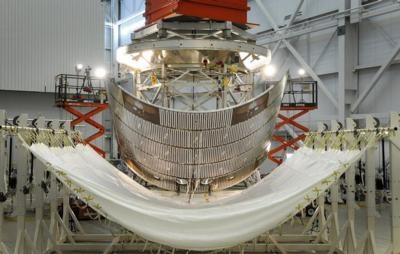Sat, Aug 01, 2015
Data From First Test Flight Makes Technology Safer, Lighter And More Reliable
Testing of design changes made to the NASA Orion spacecraft's fairing separation system have been completed by Lockheed Martin engineers. These changes resulted from data collected during Orion's first test flight on Dec. 5, 2014.

A finished Orion spacecraft has three fairings, or panels, that protect the service module radiators and solar arrays from heat, wind and acoustics during ascent into space. For the purposes of collecting data during these tests, only one fairing was separated.
The separation took about three seconds and the design changes tested were:
New push-off springs that push on the fairing for a longer period of time to provide increased safety and reliability.
As part of an ongoing mass reduction effort, the team used four crew module structural attachments instead of six.
Star trackers, or cameras that provide positioning from the stars, are used for navigation on the spacecraft. The fairing separation system pulls off the star tracker covers which prevent contamination before launch, and this process was tested for the first time.
In addition, these tests evaluated different pyrotechnic variances and higher load cases in order to prepare for Exploration Mission-1, when Orion is launched on NASA's new Space Launch System rocket. The team was also able to collect shock data, which will be provided to the European Space Agency (ESA) to support their work designing, building and testing the service module. In fact, these same fairings will be used for service module acoustics and vibe testing taking place at NASA's Plum Brook facility in Ohio later this year.
"The fairing separation is one of our very first critical events," said Mike Hawes, Lockheed Martin Orion vice president and program manager. "If it doesn't work as planned, it's probable the mission cannot continue, and tests like this help ensure it will work right the first time and every time."
(Image provided by Lockheed Martin)
More News
“Honored to accept this mission. Time to take over space. Let’s launch.” Source: SecTrans Sean Duffy commenting after President Donald Trump appointed U.S. Secret>[...]
Permanent Echo Radar signals reflected from fixed objects on the earth's surface; e.g., buildings, towers, terrain. Permanent echoes are distinguished from “ground clutter&rd>[...]
Aero Linx: European Hang Gliding and Paragliding Union (EHPU) The general aim of the EHPU is to promote and protect hang gliding and paragliding in Europe. In order to achieve this>[...]
Glider Encountered A Loss Of Lift And There Was Not Sufficient Altitude To Reach The Airport Analysis: The flight instructor reported that while turning final, the glider encounter>[...]
Airplane Climbed To 100 Ft Above Ground Level, At Which Time The Airplane Experienced A Total Loss Of Engine Power On May 24, 2025, at 1300 eastern daylight time, an Aeronca 7AC, N>[...]
 Aero-News: Quote of the Day (07.11.25)
Aero-News: Quote of the Day (07.11.25) ANN's Daily Aero-Term (07.11.25): Permanent Echo
ANN's Daily Aero-Term (07.11.25): Permanent Echo ANN's Daily Aero-Linx (07.11.25)
ANN's Daily Aero-Linx (07.11.25) NTSB Final Report: Schweizer SGS 2-33A
NTSB Final Report: Schweizer SGS 2-33A NTSB Prelim: Aeronca 7AC
NTSB Prelim: Aeronca 7AC



